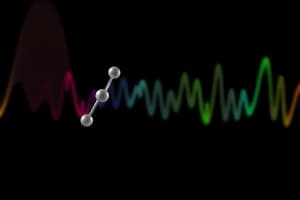Podcast
Questions and Answers
Why is fluorescence widely applied in DNA sequencing?
Why is fluorescence widely applied in DNA sequencing?
- Some dyes strongly decrease their fluorescence signal upon binding to DNA
- Many dyes easily bind to DNA
- Some dyes highly increase their fluorescence quantum yield upon binding to DNA (correct)
- Some dyes highly increase their absorption upon binding to DNA
What range of frequencies is typically utilized by medical ultrasound?
What range of frequencies is typically utilized by medical ultrasound?
- Above 100 kHz but below 20,000 kHz (correct)
- Above 20 MHz
- Below 100 kHz
- Below 20 kHz but above 20 Hz
If a 4 Tesla magnet produces EM radiation of about 300 MHz, what frequency will an 8 Tesla magnet produce with its field directed opposite?
If a 4 Tesla magnet produces EM radiation of about 300 MHz, what frequency will an 8 Tesla magnet produce with its field directed opposite?
- 300 MHz (correct)
- 600 MHz
- 900 MHz
- 150 MHz
What is the frequency at 7.05T if 13C in a 4.7T field has a frequency of 25.2?
What is the frequency at 7.05T if 13C in a 4.7T field has a frequency of 25.2?
What will the observed chemical shift be when the field strength is doubled from 5T to 10T with an initial shift of 6 PPM?
What will the observed chemical shift be when the field strength is doubled from 5T to 10T with an initial shift of 6 PPM?
Why is 13C used for NMR imaging?
Why is 13C used for NMR imaging?
Which of the following statements accurately describes an acoustic wave?
Which of the following statements accurately describes an acoustic wave?
In an energy diagram, identifying the higher energy state is crucial. Which state is correct?
In an energy diagram, identifying the higher energy state is crucial. Which state is correct?
Why are atoms like 19F and 13C used in NMR?
Why are atoms like 19F and 13C used in NMR?
How does the speed of an ultrasound wave in tissue compare to that in air?
How does the speed of an ultrasound wave in tissue compare to that in air?
What causes the chemical shift in NMR for different protons?
What causes the chemical shift in NMR for different protons?
What is the correct definition of isotopes?
What is the correct definition of isotopes?
If a magnet of 3 Tesla results in EM radiation of about 300 MHz, what radiation will a 9 Tesla magnet produce?
If a magnet of 3 Tesla results in EM radiation of about 300 MHz, what radiation will a 9 Tesla magnet produce?
Which statement best describes isomers?
Which statement best describes isomers?
If the observed chemical shift for the 5T field was 6 PPM, what could it indicate?
If the observed chemical shift for the 5T field was 6 PPM, what could it indicate?
What does a frequency of 500 MHz correspond to in terms of wavelength in air?
What does a frequency of 500 MHz correspond to in terms of wavelength in air?
What is the result of H1-H2 coupling in NMR?
What is the result of H1-H2 coupling in NMR?
What causes emission depolarization?
What causes emission depolarization?
How is fluorescence lifetime best defined?
How is fluorescence lifetime best defined?
What characteristic does a solvent-sensitive fluorophore exhibit?
What characteristic does a solvent-sensitive fluorophore exhibit?
If a complex of two proteins dissociates, what happens to the emission anisotropy of a probe attached to one of them?
If a complex of two proteins dissociates, what happens to the emission anisotropy of a probe attached to one of them?
What signifies the end of a fluorescence lifetime?
What signifies the end of a fluorescence lifetime?
Which of the following is NOT a feature of emission from a fluorophore?
Which of the following is NOT a feature of emission from a fluorophore?
Flashcards
Fluorescence in DNA sequencing
Fluorescence in DNA sequencing
Some dyes increase their fluorescence significantly when bound to DNA, making it useful in DNA sequencing.
13C NMR frequency (4.7T)
13C NMR frequency (4.7T)
At a 4.7 Tesla magnetic field, the frequency for 13C is 25.2 MHz.
13C in NMR imaging
13C in NMR imaging
13C NMR is useful for imaging because it is naturally occurring, stable, and has detectable properties.
Higher energy state in a diagram
Higher energy state in a diagram
Signup and view all the flashcards
NMR isotopes
NMR isotopes
Signup and view all the flashcards
Chemical shift in NMR
Chemical shift in NMR
Signup and view all the flashcards
NMR frequency (9T)
NMR frequency (9T)
Signup and view all the flashcards
Chemical shift (5T field)
Chemical shift (5T field)
Signup and view all the flashcards
Chemical Shift Change (Field Strength Doubled)
Chemical Shift Change (Field Strength Doubled)
Signup and view all the flashcards
Ultrasound Frequency Range
Ultrasound Frequency Range
Signup and view all the flashcards
Ultrasound Wavelength
Ultrasound Wavelength
Signup and view all the flashcards
Opposite Magnetic Field Direction Shift
Opposite Magnetic Field Direction Shift
Signup and view all the flashcards
Isotopes Definition
Isotopes Definition
Signup and view all the flashcards
Acoustic Wave Type
Acoustic Wave Type
Signup and view all the flashcards
Ultrasound Speed in Tissue vs Air
Ultrasound Speed in Tissue vs Air
Signup and view all the flashcards
Isomers Definition
Isomers Definition
Signup and view all the flashcards
Isobars
Isobars
Signup and view all the flashcards
NMR Wavelength Calculation
NMR Wavelength Calculation
Signup and view all the flashcards
H1-H2 Coupling in NMR
H1-H2 Coupling in NMR
Signup and view all the flashcards
Emission Depolarization
Emission Depolarization
Signup and view all the flashcards
Fluorescence Lifetime
Fluorescence Lifetime
Signup and view all the flashcards
Solvent-Sensitive Fluorophore
Solvent-Sensitive Fluorophore
Signup and view all the flashcards
Emission Anisotropy Change
Emission Anisotropy Change
Signup and view all the flashcards
Study Notes
DNA Sequencing and Fluorescence
- Fluorescence is widely used in DNA sequencing due to dyes that increase fluorescence upon binding to DNA.
NMR Frequency and Magnetic Field Strength
- The frequency of 13C in a 4.7T magnetic field is 25.2.
- In a 7.05T field, the corresponding frequency will be 50.4.
NMR Isotope Use
- 13C is used for NMR imaging because it is not naturally occurring.
- It is not stable and its decay can be observed
- It has a lower molecular mass.
Energy States
- In the provided diagram, state B has a higher energy than state A.
NMR Atom Use
- 19F and 13C atoms are used in NMR because they have different numbers of neutrons.
Chemical Shift in NMR
- Chemical shift differences in NMR are caused by interactions with solvents and shielding of the magnetic field by surrounding groups, electrons or protons.
NMR Radiation
- A 3 Tesla magnet produces 300 MHz EM radiation.
- A 9 Tesla magnet will produce 900 MHz radiation.
Chemical Shift Change
- If a 5T field gives a 6PPM chemical shift, doubling the field to 10T will produce a 12 PPM shift.
Acoustic Waves
- Acoustic waves are transverse waves.
Ultrasound Speed
- Ultrasound speed in tissue is lower than that in air.
Isotopes
- Isotopes are forms of an element with the same number of protons but a different number of neutrons.
Isomers
- Isomers are molecules with the same chemical formula but different spatial arrangements of atoms.
NMR Wavelength
- A 500 MHz NMR will produce a 600 mm wavelength.
H1-H2 Coupling
- H1-H2 coupling produces multiple lines in NMR.
Emission Depolarization
- Emission depolarization occurs due to the fast rotational mobility of molecules in solution .
Fluorescence Lifetime
- The fluorescence lifetime is the time it takes for the initial fluorescence intensity to decrease to half its value. The fluorescence lifetime varies from the shortest time in which a molecule can stay in the excited state to the longest time it can stay.
Studying That Suits You
Use AI to generate personalized quizzes and flashcards to suit your learning preferences.



